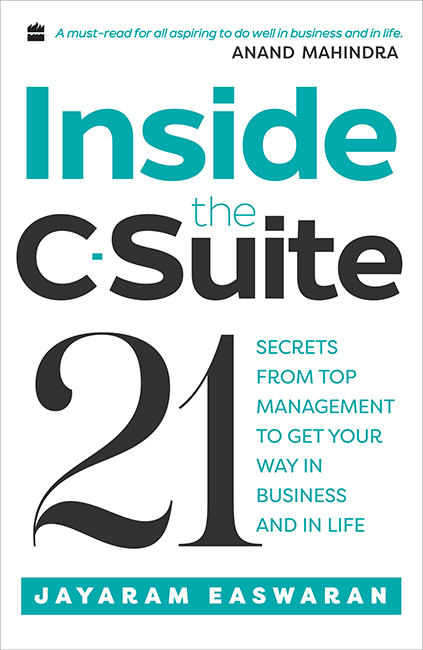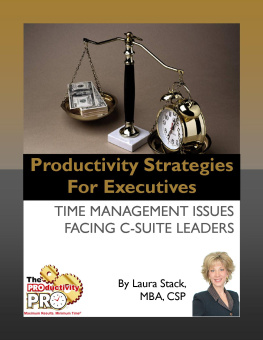Table of Contents


To
My late parents
Lt. Col. R.I. Easwaran and Madhuram Easwaran
&
Our grandchildren Arya and Rudhran
for completing the circle of life
&
My wife Jyoti for making it all happen
Contents
I n a career spanning three decades, working in the corporate sector and as a consultant, I have addressed thousands at engineering colleges and business management institutes and at other corporate forums. One question Im often asked is, What does it take to reach the top and stay there?
Be it the fancy MBA graduate in a hurry to get to the top or the patient, hardworking manager slogging at the job for years or the usual sycophant who flatters his way up the corporate ladder, the C-Suite is the ultimate aspirational destination for everyone. To all of them the C-Suite is that hallowed office reserved for those whose designations start with the letter C, with titles that read chief executive officer, chief operating officer, chief financial officer, chief marketing officer, chief people officer, chief technology officer and so on.
My answers often comprised the usual ingredients: quality education, the right experience and the requisite expertise. I knew that there was more but was unable to get a full grip on what these really were.
And then one day, I happened to see Martin Scorseses 1986 movie The Color of Money. There is a scene in which Eddie Felson (Paul Newman) tells Vincent (Tom Cruise) Ill tell you something, kiddo. You couldnt find the big time if you had a road map. You got to be a student of human moves. See, all the greats that I know of were students of human moves.
It suddenly struck me how well this applied to the business world too.
One had to be a student of human moves!
Reaching the top and staying there is all about ones ability to successfully navigate the undercurrents prevalent in the rarified environs of the C-Suite. It is how you sense and manage the egos, the politics, the insecurities, the hidden agendas and motivations of people and teams at the top. Thats not to say that such issues do not exist at lower levels. Its just that at higher levels, egos are more fragile and insecurity is at its peak.
I recall two events that exemplify this.
The first one occurred in the year 2010. I was at the Atlantis in Dubai, having breakfast with a friend who happened to be the chief operating officer of an international bank. The global banking industry had just been through a major crisis.
Hope your job is safe? I asked him.
So far, so good, he said. And continued, You know, at my level I will never lose my job because of incompetence. But yes, I could be thrown out tomorrow if I do not manage egos and insecurities amongst my colleagues at the top.
The other event happened in New Delhi in 1998. One of our divisional heads walked into my room and placed on my desk the minutes of the last review meeting.
He pointed to the first line that listed the names of all attendees.
Looks like the internal pecking order has changed again. Do you think there is a message for me? Earlier, I was at number three. Now I am at eleven.
I had no answer. I was aware that our CEO always hand- wrote the minutes in order to reduce any transcription errors.
That evening I decided to speak with the CEO.
Oh my god! Are our senior folk so insecure? I just write down the names in the order in which they sit around the table during the meeting, he said.
From then on, all names in the minutes appeared in alphabetical order.
I have worked at leadership levels across the globe in technology and brick-and-mortar companies and I believe the best way for anyone to understand what happens at higher levels in any company is to pick up a job as the executive assistant (EA) to the CEO and be the fly-on-the-wall in their office. But such opportunities are far and few in between, and I hope this book, of twenty-one short episodes, which are fictionalized accounts of real incidents over the course of my career, will provide you a ringside view of the C-Suite and what goes on in there.
Each story has an embedded message that addresses the most pertinent issues of our work lives. Stories about the dilemma of being virtuous when the stakes are high, the pitfalls of judging a book by its cover, the dangers of blind ambition, ego squabbles among top brass that can damage a firm beyond repair, and many others.
The stories are mostly drawn from a variety of Indian and trans-national companies, where, I can say with a certain degree of confidence, egos, insecurities, craving for visibility, survival strategies such as cover-your-ass (CYA) techniques, boot-licking, coteries, back-stabbing and chicanery are universal traits and are industry and culture agnostic. That does not mean that positive traits and qualities do not exist. They do and in great measure! But as is often said, when a dog bites a man it is staid news. And when a man bites a dog Ah! That is different!
This book attempts to take you on a journey that will help you understand the trials, tribulations, fun and pain that make life at the top so fascinating. It does not matter whether you are a student, a middle-or senior-level executive, or even someone occupying the C-Suite. By the time you finish reading this book, you will, hopefully, be wiser, smarter and better equipped to navigate and deal with the challenges that come your way and help you get ahead in business and in life.
Every story needs a protagonist, an antagonist and a plot where conflicts arise and get resolved. I have tried to provide these in equal measure. I have attempted to keep the language simple, taking a cue from what William Faulkner is purported to have said about Ernest Hemingway: He has never been known to use a word that might send a reader to the dictionary.
The chapters can be read in no particular order, as every story is complete in itself. This is not the outcome of any kind of behavioural research and not meant to impart any gyaan. All I have done is picked up certain insights gained over years of observation and created short stories from these and I trust that the reader will find her/his own themes and lessons in these.
Before you begin, permit me to leave you with a thought:
In every organized set-up there are four kinds of people:
The insecure ones, who often compete with their subordinates.
The political beings, forever competing with their superiors.
The mature folk who compete with their peers.
And lastly, the true leaders who compete with themselves.
Ask yourself, which category you currently belong to.
And I hope that the insights gained from reading my stories help you decide where you want to be!
T en years ago, Params father retired from the Indian Army as a colonel.
Params early memories of his home in Pune, while his father was still in service, were quite mixed. Two older brothers, his parents and two dogs lived in a spacious, red-tiled bungalow on a two-acre plot in the cantonment area. While life was comfortable, money was always in short supply. When new shoes were bought for the boys, they would always be a size or two larger. Cotton stuffing was used to make them fit and the boys had to literally grow into their shoes.
As kids, they would avoid their father if they could. Not only was he a strict disciplinarian, with him it was always a case of damned if you do, damned if you dont. As a consequence, Param and his brothers spent most of their time at Major Krishnans place, not far from where they lived. The boys never understood why the Major admired their father so much, and they really did not care so long as he and his wife were kind to them.











